Nursing Case Study: Community Support for Vision Impairment
VerifiedAdded on 2023/06/15
|5
|905
|163
Case Study
AI Summary
This nursing case study explores the impact of sudden vision loss on a family's health and well-being, focusing on the social determinants of health. The case study highlights how Tonya's blindness affects her personal health practices, coping skills, and the dynamics within her family, including her husband Robert and their children. It discusses the importance of nurse-patient relationships in providing empathetic care and the role of community-based services, such as the CNIB, in supporting individuals with visual impairments. The reflection on a group activity emphasizes the value of collaborative work in understanding community-centered approaches and improving interpersonal skills in nursing practice. The assignment underscores the need for holistic support, addressing not only the individual's health but also the broader social and economic implications for the family.
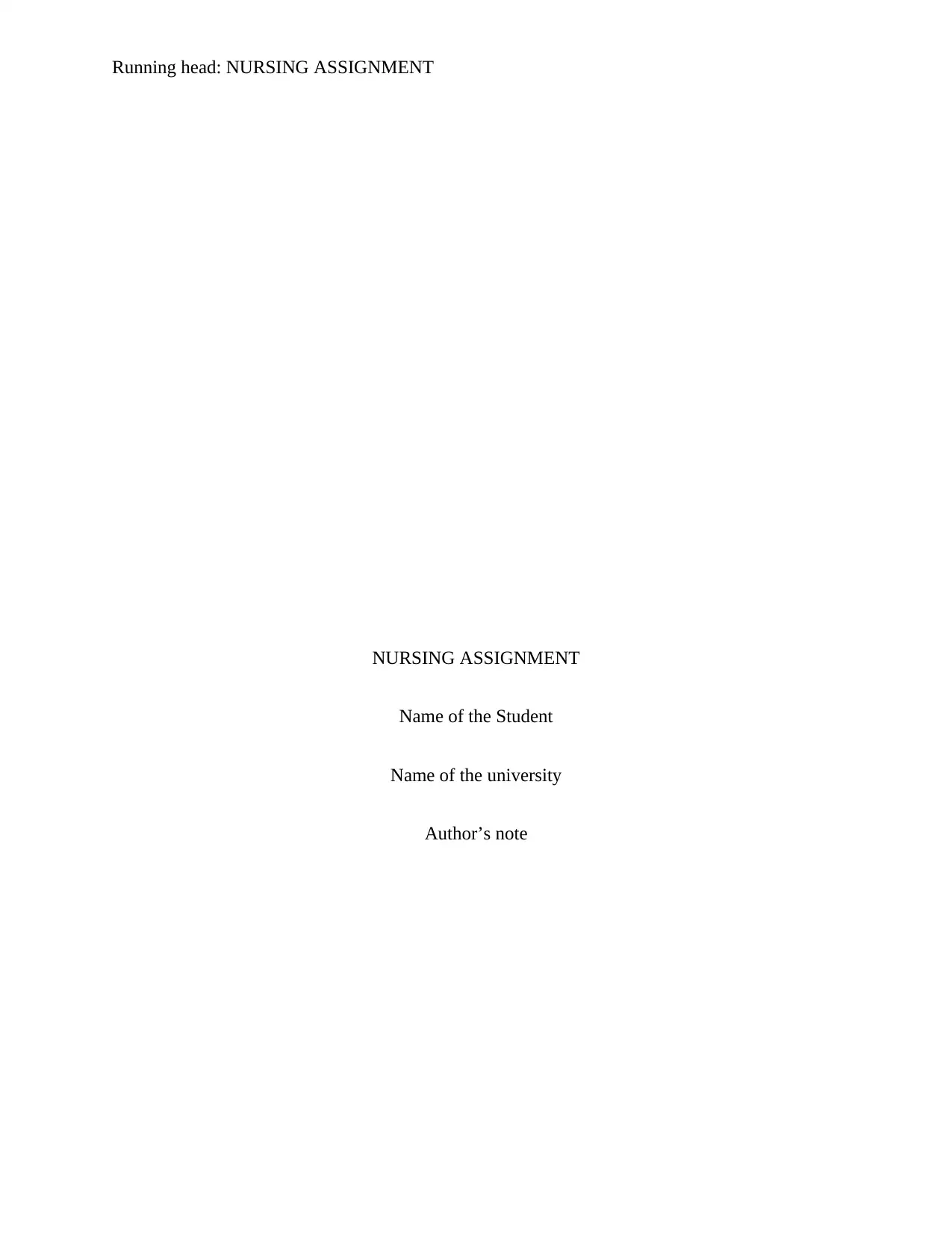
Running head: NURSING ASSIGNMENT
NURSING ASSIGNMENT
Name of the Student
Name of the university
Author’s note
NURSING ASSIGNMENT
Name of the Student
Name of the university
Author’s note
Paraphrase This Document
Need a fresh take? Get an instant paraphrase of this document with our AI Paraphraser
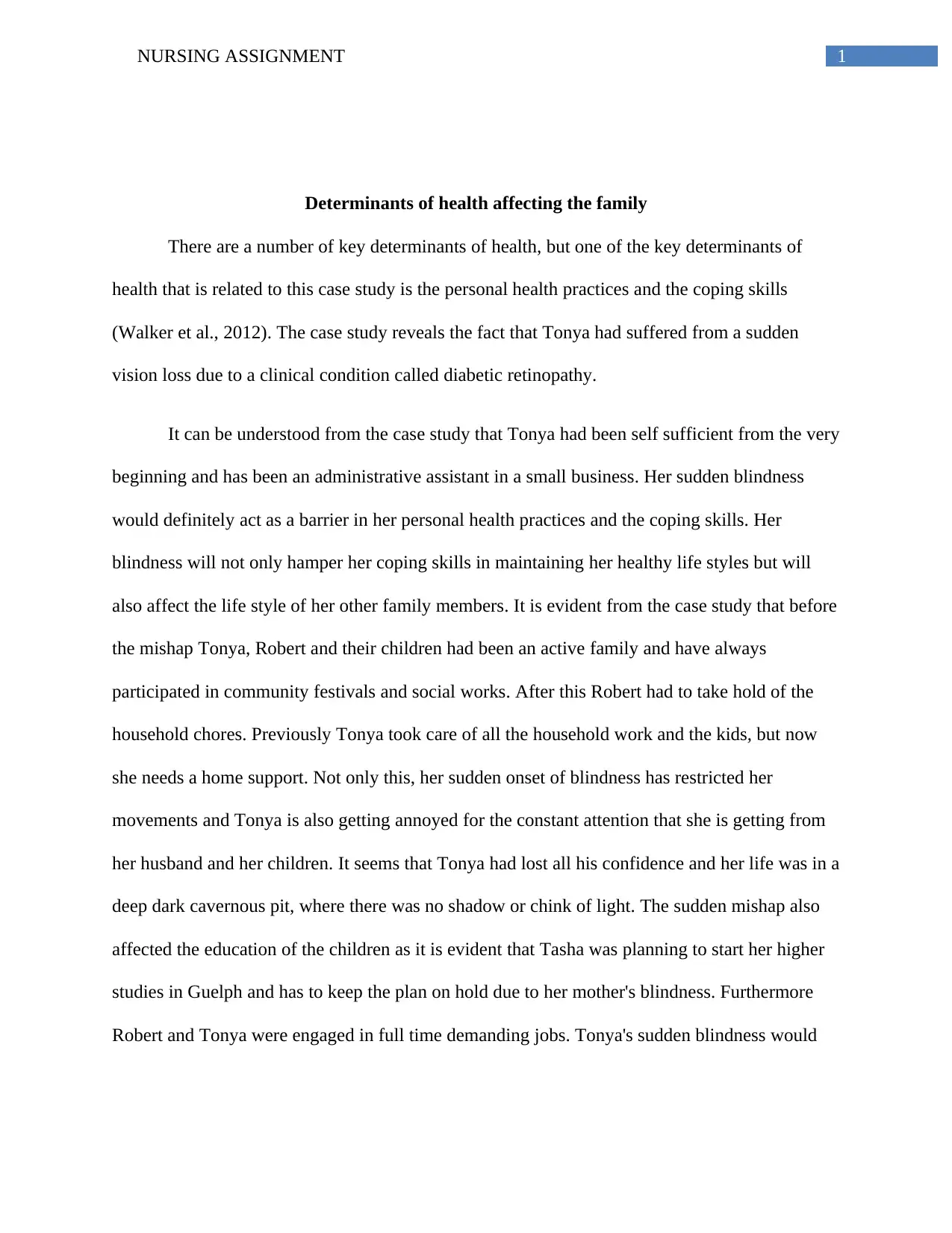
1NURSING ASSIGNMENT
Determinants of health affecting the family
There are a number of key determinants of health, but one of the key determinants of
health that is related to this case study is the personal health practices and the coping skills
(Walker et al., 2012). The case study reveals the fact that Tonya had suffered from a sudden
vision loss due to a clinical condition called diabetic retinopathy.
It can be understood from the case study that Tonya had been self sufficient from the very
beginning and has been an administrative assistant in a small business. Her sudden blindness
would definitely act as a barrier in her personal health practices and the coping skills. Her
blindness will not only hamper her coping skills in maintaining her healthy life styles but will
also affect the life style of her other family members. It is evident from the case study that before
the mishap Tonya, Robert and their children had been an active family and have always
participated in community festivals and social works. After this Robert had to take hold of the
household chores. Previously Tonya took care of all the household work and the kids, but now
she needs a home support. Not only this, her sudden onset of blindness has restricted her
movements and Tonya is also getting annoyed for the constant attention that she is getting from
her husband and her children. It seems that Tonya had lost all his confidence and her life was in a
deep dark cavernous pit, where there was no shadow or chink of light. The sudden mishap also
affected the education of the children as it is evident that Tasha was planning to start her higher
studies in Guelph and has to keep the plan on hold due to her mother's blindness. Furthermore
Robert and Tonya were engaged in full time demanding jobs. Tonya's sudden blindness would
Determinants of health affecting the family
There are a number of key determinants of health, but one of the key determinants of
health that is related to this case study is the personal health practices and the coping skills
(Walker et al., 2012). The case study reveals the fact that Tonya had suffered from a sudden
vision loss due to a clinical condition called diabetic retinopathy.
It can be understood from the case study that Tonya had been self sufficient from the very
beginning and has been an administrative assistant in a small business. Her sudden blindness
would definitely act as a barrier in her personal health practices and the coping skills. Her
blindness will not only hamper her coping skills in maintaining her healthy life styles but will
also affect the life style of her other family members. It is evident from the case study that before
the mishap Tonya, Robert and their children had been an active family and have always
participated in community festivals and social works. After this Robert had to take hold of the
household chores. Previously Tonya took care of all the household work and the kids, but now
she needs a home support. Not only this, her sudden onset of blindness has restricted her
movements and Tonya is also getting annoyed for the constant attention that she is getting from
her husband and her children. It seems that Tonya had lost all his confidence and her life was in a
deep dark cavernous pit, where there was no shadow or chink of light. The sudden mishap also
affected the education of the children as it is evident that Tasha was planning to start her higher
studies in Guelph and has to keep the plan on hold due to her mother's blindness. Furthermore
Robert and Tonya were engaged in full time demanding jobs. Tonya's sudden blindness would
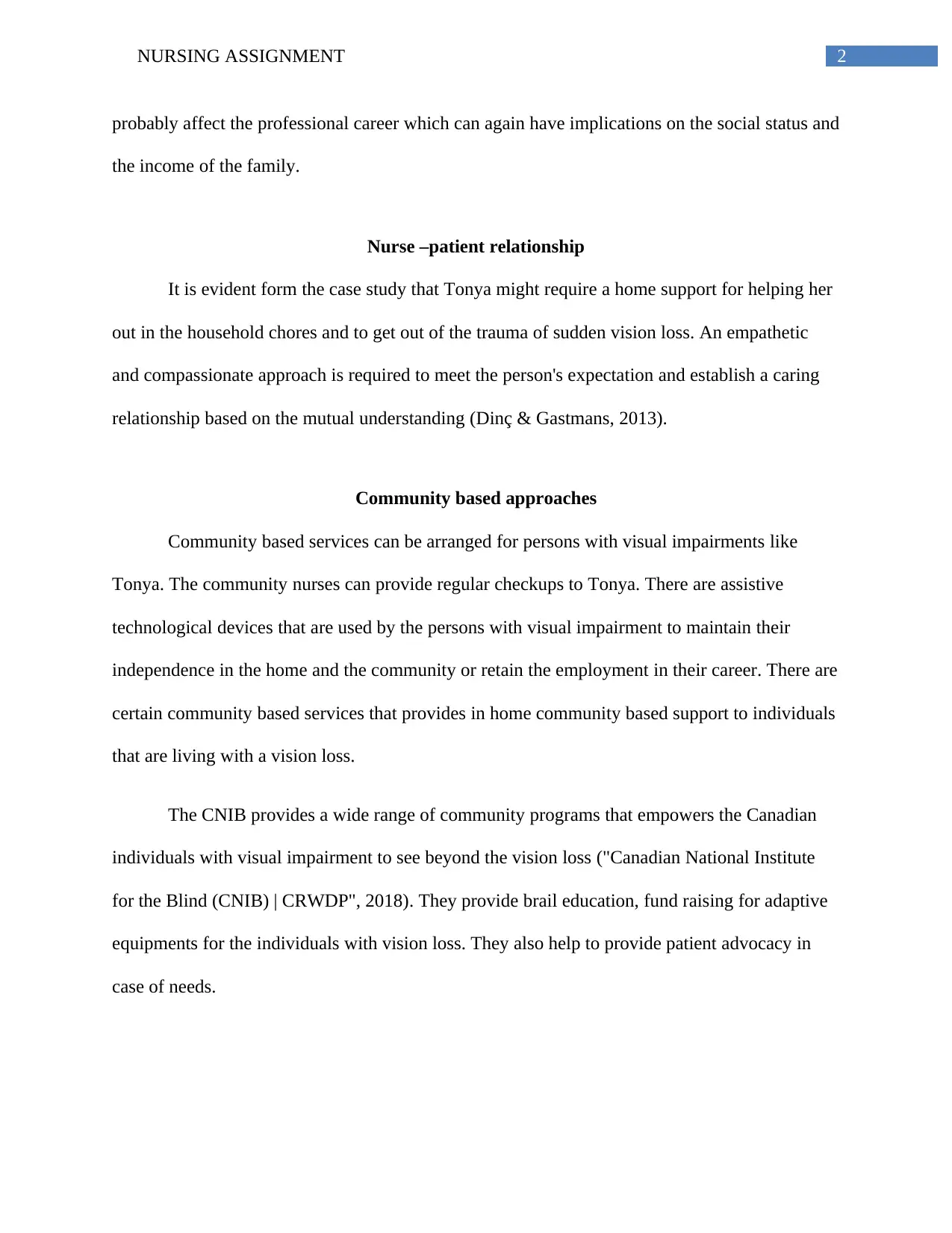
2NURSING ASSIGNMENT
probably affect the professional career which can again have implications on the social status and
the income of the family.
Nurse –patient relationship
It is evident form the case study that Tonya might require a home support for helping her
out in the household chores and to get out of the trauma of sudden vision loss. An empathetic
and compassionate approach is required to meet the person's expectation and establish a caring
relationship based on the mutual understanding (Dinç & Gastmans, 2013).
Community based approaches
Community based services can be arranged for persons with visual impairments like
Tonya. The community nurses can provide regular checkups to Tonya. There are assistive
technological devices that are used by the persons with visual impairment to maintain their
independence in the home and the community or retain the employment in their career. There are
certain community based services that provides in home community based support to individuals
that are living with a vision loss.
The CNIB provides a wide range of community programs that empowers the Canadian
individuals with visual impairment to see beyond the vision loss ("Canadian National Institute
for the Blind (CNIB) | CRWDP", 2018). They provide brail education, fund raising for adaptive
equipments for the individuals with vision loss. They also help to provide patient advocacy in
case of needs.
probably affect the professional career which can again have implications on the social status and
the income of the family.
Nurse –patient relationship
It is evident form the case study that Tonya might require a home support for helping her
out in the household chores and to get out of the trauma of sudden vision loss. An empathetic
and compassionate approach is required to meet the person's expectation and establish a caring
relationship based on the mutual understanding (Dinç & Gastmans, 2013).
Community based approaches
Community based services can be arranged for persons with visual impairments like
Tonya. The community nurses can provide regular checkups to Tonya. There are assistive
technological devices that are used by the persons with visual impairment to maintain their
independence in the home and the community or retain the employment in their career. There are
certain community based services that provides in home community based support to individuals
that are living with a vision loss.
The CNIB provides a wide range of community programs that empowers the Canadian
individuals with visual impairment to see beyond the vision loss ("Canadian National Institute
for the Blind (CNIB) | CRWDP", 2018). They provide brail education, fund raising for adaptive
equipments for the individuals with vision loss. They also help to provide patient advocacy in
case of needs.
⊘ This is a preview!⊘
Do you want full access?
Subscribe today to unlock all pages.

Trusted by 1+ million students worldwide
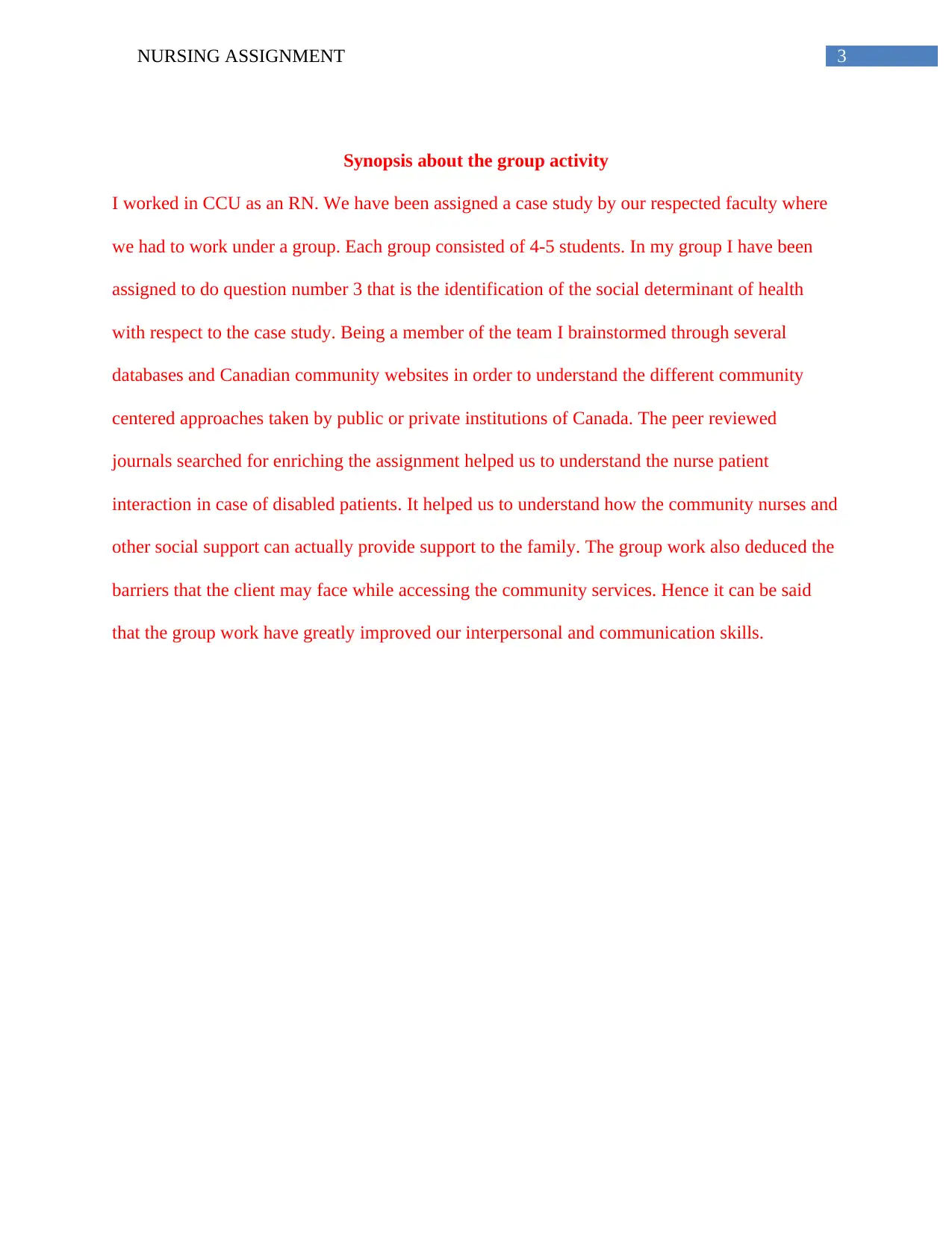
3NURSING ASSIGNMENT
Synopsis about the group activity
I worked in CCU as an RN. We have been assigned a case study by our respected faculty where
we had to work under a group. Each group consisted of 4-5 students. In my group I have been
assigned to do question number 3 that is the identification of the social determinant of health
with respect to the case study. Being a member of the team I brainstormed through several
databases and Canadian community websites in order to understand the different community
centered approaches taken by public or private institutions of Canada. The peer reviewed
journals searched for enriching the assignment helped us to understand the nurse patient
interaction in case of disabled patients. It helped us to understand how the community nurses and
other social support can actually provide support to the family. The group work also deduced the
barriers that the client may face while accessing the community services. Hence it can be said
that the group work have greatly improved our interpersonal and communication skills.
Synopsis about the group activity
I worked in CCU as an RN. We have been assigned a case study by our respected faculty where
we had to work under a group. Each group consisted of 4-5 students. In my group I have been
assigned to do question number 3 that is the identification of the social determinant of health
with respect to the case study. Being a member of the team I brainstormed through several
databases and Canadian community websites in order to understand the different community
centered approaches taken by public or private institutions of Canada. The peer reviewed
journals searched for enriching the assignment helped us to understand the nurse patient
interaction in case of disabled patients. It helped us to understand how the community nurses and
other social support can actually provide support to the family. The group work also deduced the
barriers that the client may face while accessing the community services. Hence it can be said
that the group work have greatly improved our interpersonal and communication skills.
Paraphrase This Document
Need a fresh take? Get an instant paraphrase of this document with our AI Paraphraser
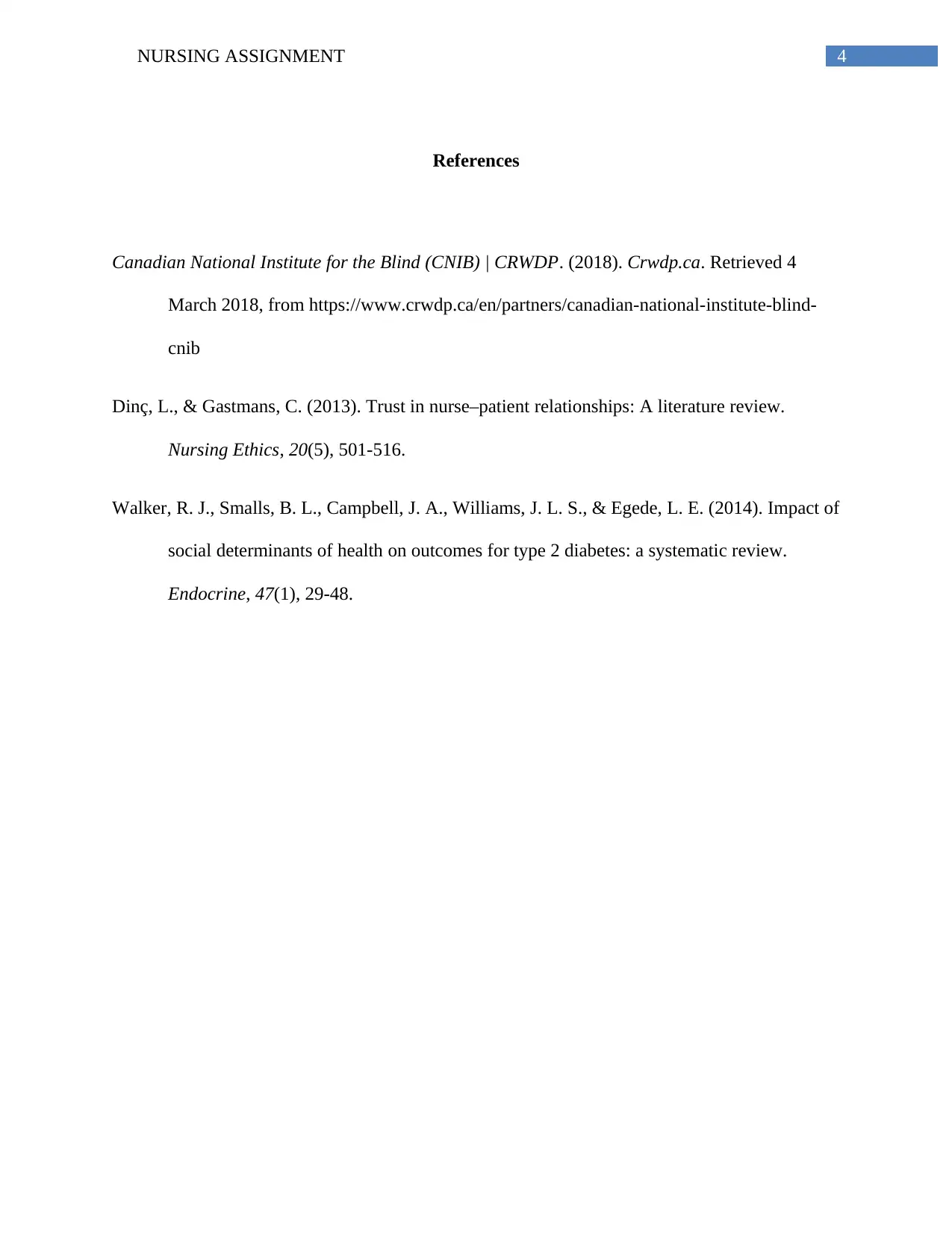
4NURSING ASSIGNMENT
References
Canadian National Institute for the Blind (CNIB) | CRWDP. (2018). Crwdp.ca. Retrieved 4
March 2018, from https://www.crwdp.ca/en/partners/canadian-national-institute-blind-
cnib
Dinç, L., & Gastmans, C. (2013). Trust in nurse–patient relationships: A literature review.
Nursing Ethics, 20(5), 501-516.
Walker, R. J., Smalls, B. L., Campbell, J. A., Williams, J. L. S., & Egede, L. E. (2014). Impact of
social determinants of health on outcomes for type 2 diabetes: a systematic review.
Endocrine, 47(1), 29-48.
References
Canadian National Institute for the Blind (CNIB) | CRWDP. (2018). Crwdp.ca. Retrieved 4
March 2018, from https://www.crwdp.ca/en/partners/canadian-national-institute-blind-
cnib
Dinç, L., & Gastmans, C. (2013). Trust in nurse–patient relationships: A literature review.
Nursing Ethics, 20(5), 501-516.
Walker, R. J., Smalls, B. L., Campbell, J. A., Williams, J. L. S., & Egede, L. E. (2014). Impact of
social determinants of health on outcomes for type 2 diabetes: a systematic review.
Endocrine, 47(1), 29-48.
1 out of 5
Related Documents
Your All-in-One AI-Powered Toolkit for Academic Success.
+13062052269
info@desklib.com
Available 24*7 on WhatsApp / Email
![[object Object]](/_next/static/media/star-bottom.7253800d.svg)
Unlock your academic potential
Copyright © 2020–2025 A2Z Services. All Rights Reserved. Developed and managed by ZUCOL.





